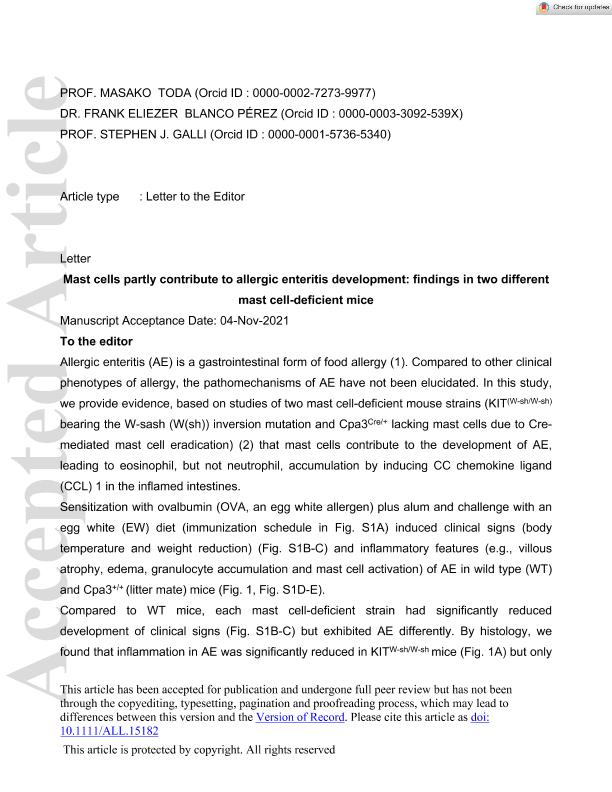Mostrar el registro sencillo del ítem
dc.contributor.author
Blanco Pérez, Frank
dc.contributor.author
Gonzalez Menendez, Irene
dc.contributor.author
Stassen, Michael
dc.contributor.author
Kato, Yoichiro
dc.contributor.author
Laiño, Jonathan Emiliano

dc.contributor.author
Kirberg, Jörg
dc.contributor.author
Krause, Maren
dc.contributor.author
Martella, Manuela
dc.contributor.author
Shibata, Noriyuki
dc.contributor.author
Quintanilla-Martinez, Leticia
dc.contributor.author
Feyerabend, Thorsten B.
dc.contributor.author
Rodewald, Hans Reimer
dc.contributor.author
Galli, Stephen J.
dc.contributor.author
Vieths, Stefan
dc.contributor.author
Scheurer, Stephan
dc.contributor.author
Toda, Masako
dc.date.available
2022-03-22T10:59:37Z
dc.date.issued
2021-11
dc.identifier.citation
Blanco Pérez, Frank; Gonzalez Menendez, Irene; Stassen, Michael; Kato, Yoichiro; Laiño, Jonathan Emiliano; et al.; Mast cells partly contribute to allergic enteritis development: Findings in two different mast cell-deficient mice; Wiley Blackwell Publishing, Inc; Allergy; 77; 3; 11-2021; 1051-1054
dc.identifier.issn
0105-4538
dc.identifier.uri
http://hdl.handle.net/11336/153712
dc.description.abstract
Allergic enteritis (AE) is a gastrointestinal form of food allergy. The presence of mast cells and granulocytes has been detected in the inflamed tissues in AE. In this study, we aimed to elucidate the role of mast cells in AE development using two mast cell-deficient mouse strains: KIT(W-sh/W-sh) bearing the W-sash (W(sh)) inversion mutation and Cpa3Cre/+, which lack mast cells due to Cre-mediated mast cell eradication, were used in an AE experimental model. The development of clinical symptoms (e.g. drop in body temperature and weight loss) were abolished in both strains, whereas inflammatory levels of AE (e.g. villous atrophy, edema, and granulocyte accumulation) were reduced mainly in KITW-sh/W-sh mice. FACS analysis of the KITW-sh/W-sh intestinal lamina propria, showed a reduction in the eosinophil (CD45+CD11b+SiglecF+cells) and neutrophil (CD45+CD11b+SiglecF−Ly6G+ cells) accumulation. Cpa3Cre/+ mice showed reduced eosinophil (CD45+CD11b+SiglecF+cells) accumulation, but neutrophil (CD45+CD11b+SiglecF−Ly6G+ cells) accumulation was retained at AE sites. The concentrations of CC chemokine ligand 1 (CCL1), a known CC chemokine receptor 8 ligand leading to eosinophil recruitment, was reduced in intestinal homogenates of both mast cell-deficient mouse strains. These results suggest that mast cells play a role in AE development in part by expressing CCL1 and contributing to eosinophil accumulation at AE. This study offers implications for establishing AE treatments that target infiltrating leucocytes in AE tissues.
dc.format
application/pdf
dc.language.iso
eng
dc.publisher
Wiley Blackwell Publishing, Inc

dc.rights
info:eu-repo/semantics/openAccess
dc.rights.uri
https://creativecommons.org/licenses/by-nc/2.5/ar/
dc.subject
ALLERGIC ENTERITIS
dc.subject
EOSINOPHIL
dc.subject
FOOD ALLERGY
dc.subject
MAST CELLS
dc.subject
MOUSE MODEL
dc.subject.classification
Inmunología

dc.subject.classification
Medicina Básica

dc.subject.classification
CIENCIAS MÉDICAS Y DE LA SALUD

dc.title
Mast cells partly contribute to allergic enteritis development: Findings in two different mast cell-deficient mice
dc.type
info:eu-repo/semantics/article
dc.type
info:ar-repo/semantics/artículo
dc.type
info:eu-repo/semantics/publishedVersion
dc.date.updated
2021-12-13T19:17:54Z
dc.identifier.eissn
1398-9995
dc.journal.volume
77
dc.journal.number
3
dc.journal.pagination
1051-1054
dc.journal.pais
Reino Unido

dc.journal.ciudad
Londres
dc.conicet.avisoEditorial
This is an open access article under the terms of the Creative Commons Attribution-NonCommercial License, which permits use, distribution and reproduction
in any medium, provided the original work is properly cited and is not used for commercial purposes.
© 2021 The Authors. Allergy published by European Academy of Allergy and Clinical Immunology and John Wiley & Sons Ltd.
dc.description.fil
Fil: Blanco Pérez, Frank. No especifíca;
dc.description.fil
Fil: Gonzalez Menendez, Irene. No especifíca;
dc.description.fil
Fil: Stassen, Michael. Johannes Gutenberg Universitat Mainz; Alemania
dc.description.fil
Fil: Kato, Yoichiro. Tokyo Women's Medical University; Japón
dc.description.fil
Fil: Laiño, Jonathan Emiliano. Consejo Nacional de Investigaciones Científicas y Técnicas. Centro Científico Tecnológico Conicet - Tucumán. Centro de Referencia para Lactobacilos; Argentina
dc.description.fil
Fil: Kirberg, Jörg. No especifíca;
dc.description.fil
Fil: Krause, Maren. No especifíca;
dc.description.fil
Fil: Martella, Manuela. No especifíca;
dc.description.fil
Fil: Shibata, Noriyuki. Tokyo Women's Medical University; Japón
dc.description.fil
Fil: Quintanilla-Martinez, Leticia. No especifíca;
dc.description.fil
Fil: Feyerabend, Thorsten B.. No especifíca;
dc.description.fil
Fil: Rodewald, Hans Reimer. No especifíca;
dc.description.fil
Fil: Galli, Stephen J.. University of Stanford; Estados Unidos
dc.description.fil
Fil: Vieths, Stefan. No especifíca;
dc.description.fil
Fil: Scheurer, Stephan. No especifíca;
dc.description.fil
Fil: Toda, Masako. No especifíca;
dc.journal.title
Allergy

dc.relation.alternativeid
info:eu-repo/semantics/altIdentifier/doi/https://doi.org/10.1111/all.15182
dc.relation.alternativeid
info:eu-repo/semantics/altIdentifier/url/https://onlinelibrary.wiley.com/doi/10.1111/all.15182
Archivos asociados
